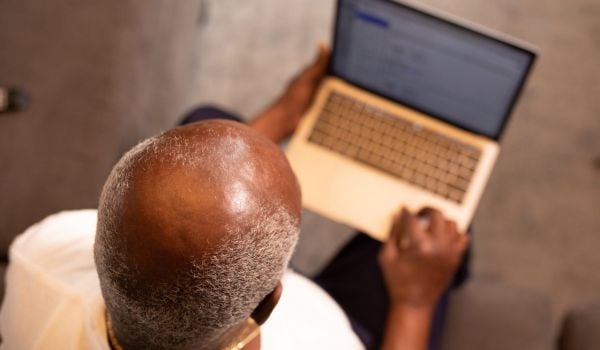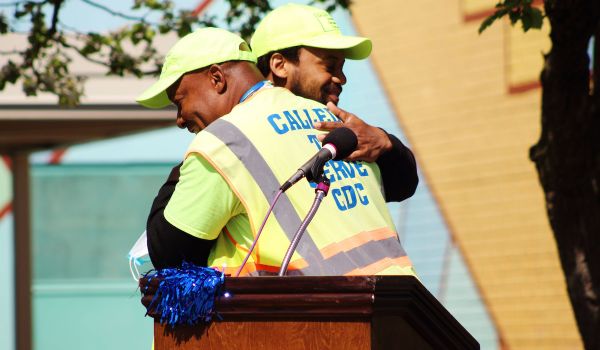Iona Livingston, 53, always wanted to work in a hospital setting. To get there, she is enrolled in an associate’s degree program to learn medical coding. Livingston says her three children are grown and out of the house, so she is “living my life for me now.” She completed her GED last year, which made her feel she was “on a roll,” so she signed up for college.

Livingston also works full-time in a Philadelphia mailroom. The physical labor involved with lifting and carrying packages combined with rushing from work to get to classes was taking a toll on her body, she says. “Classes end at 9:30 [p.m.]. I would have to come in earlier than my normal hours and I would have to get off at 5 just to get down there,” Livingston says.
Recognizing the strain the commuting was putting on Livingston, a staff member at the college told her she was eligible for Internet Essentials, Comcast’s low-cost broadband service for low-income people, and that she could do her coursework from home.
“When I get off of work, I’m able to go home, shower, throw on my sweatpants, and submit all the things I need to do,” Livingston says. “It gets done.”
Livingston had been a Comcast customer before returning to school, and that experience left her dubious. “They had it where you were sharing your internet and everything with your neighbors, and it was always running slow. And it was always cutting off, and you couldn’t log onto it,” Livingston says. (A Comcast spokesperson clarified that Comcast “customers do not share internet.”) The service, she says, was also expensive. “I didn’t know internet was more expensive than cable,” she told Next City. But, Comcast’s low-cost program “fit in my budget,” she says, noting that the service “works a lot better than before.”
Internet Essentials offers a broadband connection for under $10 per month. Originally, the program targeted families with children, using eligibility for free school lunches as a qualifying factor. But in early August, Comcast announced that it would expand Internet Essentials to people eligible for a range of public benefits. Those benefits include the Supplemental Nutrition Assistance Program (SNAP), Medicaid and Supplemental Security Income (SSI). The program, created in 2011 as part of the agreement reached when Comcast purchased NBC Universal, serves two million households currently; The company’s obligations to continue Internet Essentials ended in June 2014, a spokesperson said; however, the company continues to offer the program. The expansion will enable another three million low-income households to get online.
While the program expands access to a segment of the population often excluded from broadband service, advocates say it’s not a perfect solution.
“We’re trying to rest the entire future of the gig economy, the education of children, democracy on [a program] Comcast writes off on its taxes,” says Hannah Jane Sassaman, policy director at Philadelphia’s Media Mobilizing Project.
Not surprisingly, Sassaman says that one lesson Comcast’s Internet Essentials program has offered is that cost is a major barrier to getting people online. Philadelphia tied with Memphis as the second-worst city for internet penetration in the U.S. in 2017. Detroit ranked number one, which suggests a combination of factors such as poverty and a lack of infrastructure. Meanwhile, Philly ranks third for the number of people who have signed up for Internet Essentials, behind Chicago and Houston, officials told the Philadelphia Inquirer.
Sassaman also criticizes the speed of the Internet Essentials program. At 15 Mbps, the speed doesn’t measure up to the Federal Communications Commission’s definition of broadband (but is enough, the FCC says, to handle email, streaming, and online gaming).
One solution to both the speed and cost issue is for cities to invest in creating their own networks. Philadelphia even tried to create its own more than a decade ago. Costs, political antipathy and pressure from private ISPs doomed the project.
No surprise there. As anyone who has followed the Google Fiber saga knows, creating a new network is expensive. And connecting that network to low-income families’ homes is even more so.
Christopher Mitchell runs the Institute for Local Self Reliance’s Community Broadband Networks Initiative. He says that figuring out how to provide broadband access to low-wealth, urban, single-family homes is “the single hardest problem to solve in broadband policy.” The cost of installing fiber-optic cables that can provide the highest-quality internet service runs around $2,000 per single-family home.
These investments, says Mitchell, typically come from private sources, not public ones. “That model doesn’t lend itself well to connecting low-income households,” he says. “That model lends itself to building a network that can connect people who can pay to have a connection. Y’know, the $40-$50 a-month-kinds of households,” Mitchell says. (A Comcast spokesperson said that the company invests constantly in its infrastructure to add value for its customers and that it sets prices in line with competitors and in order to remain profitable.) Mitchell praises Comcast’s efforts to serve low-income families with its $10 per month service, but he cautions, even that amount may be too high for the lowest income people in the U.S. “We need a different way of thinking about things,” he says.
Mitchell adds that Comcast “has a mixed record in promoting the program and even at best is limited in how it can spread the word.” With three million households suddenly eligible for the low-cost program, Mitchell suggests that local governments inform residents about the Internet Essentials program at places like schools and centers providing social services.
Mitchell believes that publicly owned internet infrastructure is one possible strategy to address the larger digital divide. “Historically,” Mitchell says, “most municipal networks have been built to create high-tech jobs or a better business climate, often for middle-class jobs.” Yet he says that cities are increasingly looking at creating their own networks to provide connections for low-income residents.
He says that if a city such as Seattle treated its internet network the same way it does a road, it could invest with no expectation of earning that investment back. “You build a fiber network to a low-income area, and then when revenues are generated [they] pay for the operation of the network … It’s a one-time subsidy to get the network there. It can deliver internet access to all … households at $10 a month, and it could charge higher-income households $40 per month.” By treating an internet network like any other sort of infrastructure, Mitchell speculates that it could contribute to improved equity and education outcomes and reduce crime. Even as he proposes this solution, however, Mitchel says most politicians won’t risk their careers on such a plan since it would likely produce substantial blowback.
In the meantime, Mitchell says broadband rates are “unnecessarily high” because government policies have allowed large providers such as Comcast and AT&T to avoid stiff competition. He points to the wireless market as an example of how companies can target specific demographics while saying “it’s impractical” to imagine that a company would go to the expense of building a new network to challenge Comcast in low-income communities. “But if we have public policy that builds networks that are open to multiple competitors, there are business models that would compete for the scarce dollars of low-income households,” he says.
“Every policy has allowed Comcast and other companies to monopolize this service, and I appreciate that Comcast is making a difference with the power it has, even as I want to fix the market,” Mitchell says.
This story was produced with support from Broke in Philly, a collaborative reporting project on solutions to poverty and the city’s push toward economic justice. Next City is one of more than 20 news organizations in the collective. Follow us on Twitter @BrokeInPhilly.
Update: This story has been updated to clarify a few items. First, a Comcast spokesperson clarified that customers do not share Internet, contrary to Ms. Livingston’s understanding of her previous Comcast agreement. Second, we’ve added a line saying that Comcast’s legal obligation to continue Internet Essentials ended five years ago. Third, we’ve updated the line from Comcast about how it prices its products.

Zoe Sullivan is a multimedia journalist and visual artist with experience on the U.S. Gulf Coast, Argentina, Brazil, and Kenya. Her radio work has appeared on outlets such as BBC, Marketplace, Radio France International, Free Speech Radio News and DW. Her writing has appeared on outlets such as The Guardian, Al Jazeera America and The Crisis.
Follow Zoe .(JavaScript must be enabled to view this email address)
















